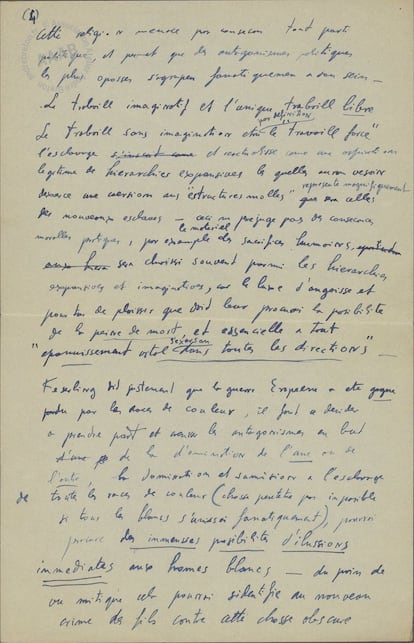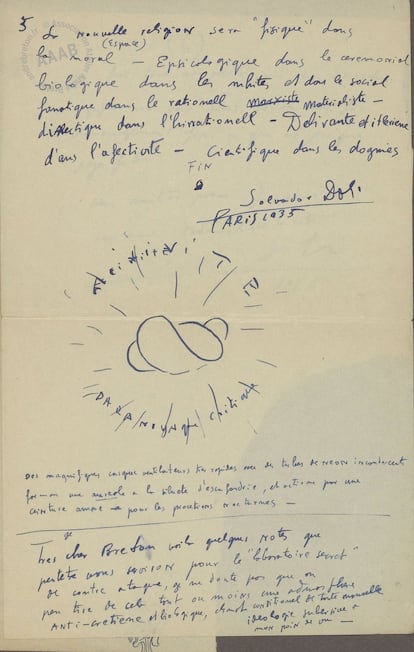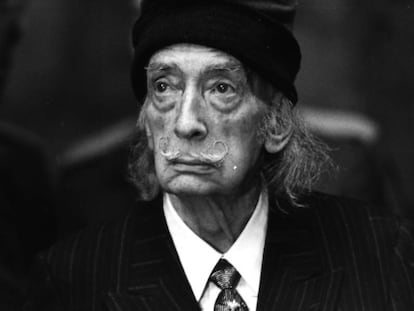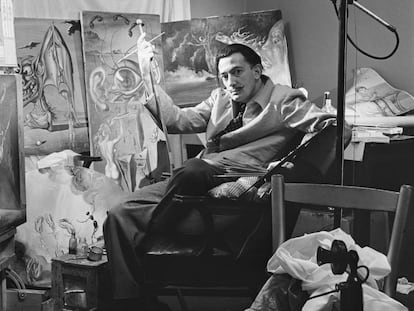The day Salvador Dalí invented a racist religion
An unpublished letter from the artist reveals the sado-masochistic, atheistic and scientific creed that got him expelled from the Surrealists

Salvador Dalí was serious when he said: “Christ was an amateur when it came to creating a religion.” The painter from Empordà (northeastern Spain) had decided to invent his own religion in the 1930s. He told writer and journalist Alain Bosquet about it in an interview, and mentioned it briefly in his memoir, Diary of a Genius. “Precisely because Breton [André Breton, the French co-founder of surrealism] did not want to hear about it, I set out to invent a new religion that would be sadistic, masochistic, surreal and paranoid.” The letter from Dalí to Breton in 1935 was recently re-discovered during a search of the French writer’s digital archive. It has never been published but was once partially quoted by art historian, William Jeffett. The letter presents Dalí's idea and offers some insights into why the artist was expelled from the Surrealists in 1939. Breton kept the letter as evidence against him.
In the letter, Dalí writes: “I believe more and more that we surrealists are turning into priests. It is an idea that has been haunting me for a long time now, so much so that one of my urgent projects is to invent a religion, since there can be no priests without religion… It is an essentially anti-Christian and materialistic religion based on the progress of specific sciences.” In other words, a godless and scientific religion.
Dalí dreamt this up when Hitler, Mussolini and Stalin were in power, and while the ultra-right was taking over the French Parliament. Things in Europe were so dire that André Breton partnered with one of his biggest rivals, French philosopher Georges Bataille, to found a group of intellectuals that published anti-fascist essays in Contre-attaque (or, Counterattack) magazine. Their aim was to combat fascism and promote a proletarian revolution free from the constraints imposed by the Communist Party. Bataille believed that the fascists must be doing something right to attract so many followers. He thought that the affective (emotional) sphere – myths and fanaticism – was the reason for their success. Bataille concluded that fanatical violence – “an obstinate dictatorship by an armed populace” – was the only way to fight fanatical fascism.

Dalí was not a Marxist, especially during his marriage to Gala Diakonova – a Russian woman who was very familiar with Stalin’s tyranny – but he didn’t believe in democracy either. He believed that one had to understand Nazi leader Adolf Hitler in order to fight him, so he analyzed the Führer using his own “Paranoiac Critical” method, based on the theories of Freud and Lacan. The objective of this method was to lay bare the subconscious desires that reason and Christian morality strive to repress. A year earlier, Dalí had depicted a naked and sexually suggestive Führer wearing only a military belt on a milky white body, evoking his painting of a swastika-adorned wet nurse from his infancy. By applying his paranoid delusions to Hitler, Dalí risked becoming enraptured by what he saw, which resulted in his temporary expulsion from the Surrealists in 1934.
Dalí thought that Christianity could only be successfully replaced by another religion, so he set about creating one from the muddled stew of ideas he was reading about at the time. Without any citations, he mixes in ideas from the scientific religion developed by Auguste Comte, and its Catalan version, Hiparxiologia, developed by Francesc Pujols. Dalí tosses in a pinch of Spengler-inspired mathematical analysis of the rise and fall of empires by his childhood friend, Alexandre Deulofeu (author of The Mathematics of History), large measures of psychoanalysis, and a sprinkling of ideas from Bataille, Einstein, Sade and Breton himself.
The two main factions of Contre-attaque were the Sade group and the Marat group. Although he never joined either one, Dalí proposes in his letter to Breton the “annihilation of the scandalous inflation of Christian ‘altruism.’ We don’t want happiness for all men, rather the happiness of some to the detriment of others, since oppression and suffering are primordial psychological, biological and physical conditions for the happiness of the rest.” Dalí uses Sade’s principle of pleasure and pain to shockingly propose “human sacrifice, that is, the apotheosis of ‘injustice’ in the Christian sense of the word.”
Dalí's religion was also masochistic. In his letter, Dalí says the elite classes would have to make some sacrifices. “For example, human sacrifices will often be chosen from the wealthy and creative hierarchies, because it is essential for them to experience a potential death penalty, which satisfies their lust for pain and therefore pleasure.”
The painter dubiously believed that every phenomenon that disrupts an intellectual conviction is revolutionary, and Nazism was exactly that, said Dalí. It was “hyper-original” in that it stirred up the real and raw anxieties always underestimated by Marxism. He even said that Nazism was an example of surrealist government, and the swastika was a surrealist symbol. “The new religion,” writes Dalí, “will morally support every subversive movement in the political domain, by constituting an anarchic amalgam of all revolutionary ideologies, even if their aspirations bear reactionary labels.” In his delirium, he argues that a new order would destroy the distinction between right and left, “between the good and evil of Christianity.”

His obsession for developing a new human spirituality by fighting Nazi irrationality with more irrationality pushed Dalí to the other extreme – an abyss of anti-humanist cruelty. The same year that Hitler signed the racist Nuremberg laws, the painter proposed replacing class struggle with a racial struggle. Confronted by Nazi racism, he espouses more racism. “The domination or submission to slavery of all the colored races” could be possible, Dalí said, “if all the whites united fanatically.”
In 1939, when Dalí no longer tried to hide his support for Spanish dictator Francisco Franco and had crowned himself the king of surrealism in the United States, Breton finally decided to permanently expel him from the Surrealists, citing his racism. “I learned about it directly from him,” said Breton, “and I made sure that his [letter] was not trying to be humorous.” Breton had kept Dalí's letter as proof. He had also received an even crueler letter from Dalí, but only a handwritten copy made by Breton has survived. The chilling letter that the archive definitively attributes to Dalí says, “I declare that even though I may have pity and a negative opinion of the cruel lynchings and bonfires, I admit to feeling real pleasure and considerable sexual excitement in reading about such things, and I do not intend to censure those who burn Blacks alive and lynch them. I have to consider the legitimate pleasure that drives these people… although I reject the odious social reasons beyond passion and pleasure that are causes of such conflicts.”
Just like the Marquis de Sade’s infamous perversions conceived while imprisoned in the Bastille, Dalí's own deliriums amounted to nothing more than fanciful words. Years later, he reverted to a bombastic Catholic mysticism while living in Franco’s Spain, but his unpublished letters are a shocking reminder about the dangers of irrationalism and its anarchic-authoritarian leanings.
Full transcript of Salvador Dalí's letter to André Breton in 1935
I believe more and more that we surrealists are turning into priests. It is an idea that has been haunting me for a long time now, so much so that one of my urgent projects is to invent a religion, since there can be no priests without religion. Unfortunately, I do not have time. Although I should start soon, it is not extremely urgent since the question has not been around for two hundred years.
Here are some summarized ideas extracted from my papers:
It is an essentially anti-Christian and materialistic religion based on the progress of specific sciences.
This religion is equal to any other, and like any true conquest of civilization, will arise from the need to defend it from the overwhelming supremacy of nature, to which I would add a second motive: the imperious desire to correct the imperfections of culture, “painfully felt” imperfections (Freud).
According to psychoanalysis, the mythical point of view says religion originates in the father-son relationship. God is an exalted father and the longing for the father is the root of the religious need. The emotional myth of the new religion must renew the primitive crime of the father, but without incorporating the feeling of guilt, which is made possible by the new surrealistic moral climate. It is the religion of children for the slavery of William Tell, for the slavery of god, an anti-pantheistic rage and a ceremonial discrediting of nature.
It is a defiant revival of all types of ceremonies based on an extremely individual and personal study of neurotic ceremonies and all the unapproachable resources of transformation, of which we surrealists are specialists.
The need to anticipate emotional solutions that extend beyond the rational frameworks regarding “death,” and the potential for a moral divination of the future (based on the organization of objective chance using the paranoiac-critical method, etc.).
These solutions, the result of progress made by specific sciences, are subject to the state of these very sciences regardless of their subject matter, and are on the same physical plane as the expansion of the universe (for example), as Eddington conceives it.
From the point of view of the Moral Revolution, [we seek] the annihilation of the scandalous inflation of Christian “altruism.” We don’t want happiness for all men, rather the happiness of some to the detriment of others, since oppression and suffering are primordial psychological, biological and physical conditions for the happiness of the rest.
New hierarchies, more brutal and stricter than ever before, must be established by the progress of specific sciences and also by seemingly arbitrary persons and by the objective imagination resulting from new religious creeds.
Verification of the widest and highest “vital” plenitudes of man in every sense, to the detriment of some others on which will fall the cruelty and cataclysms of plenitude, aggression, annihilation, “experimental” sadism and even the hyperesthesia of ephemeral caprice. Human sacrifice: that is, the apotheosis of “injustice” in the Christian sense of the word.
For all those imbued with the real spirit of man and pre-established condition, the suppression of all coercive systems will result in the vital plenitude of new civilizations of uniform color, in which these transitory uncivilized and primary characters will exercise a primitive, original, totemic and paternal role.
The new religion will morally support every subversive movement in the political domain, by encompassing an anarchic amalgam of all revolutionary ideologies, even if their aspirations bear reactionary labels.
Amalgamation, anarchic confusion and the most complete subversive antagonisms will be incorporated as positive signs of the destruction of coercion. The elites of the new hierarchies that extend in every direction will thus destroy the flat geometry of Euclidean politics occupying the miserable space between right and left, all those on both the right and the left, and between the good and evil of Christianity.
This religion will thus threaten all political parties and allow the most vehement political antipathies to fanatically cluster in its midst.
Work without imagination is by definition forced labor, slavery, and will be a legitimate aspiration of the new hierarchies, which will need to exercise force on the “weak structures” represented magnificently in the new slaves.
This does not prejudge any practical moral consequences. For example, human sacrifices will often be chosen from the wealthy and creative hierarchies, because it is essential for them to experience a potential death penalty, which satisfies their “lust for pain and therefore pleasure.”
Keyserling rightly says that the European war was won by the colored races, so it is necessary to choose to aggravate the antagonisms according to the dominance of one or the other. The domination or submission to slavery of all the colored races, (something that may be possible if all whites were fanatically united), could produce immense possibilities of immediate illusions for white men. From the mythical point of view, this could be identified with a new crime of the sons against this dark thing.
The new religion will be physical in the moral, psychological in the ceremonial, biological in the mythical and in the social, and fanatical in the rational-materialistic, dialectical in the irrational, delirious and Hitlerian in the emotional, and scientific in the dogmatic.
ACTIVITY
[Here Dalí includes a drawing of a yin and yang symbol]
PARANOIAC-CRITICAL
[A reference to the self-portrait on the last page of the letter]: Two enormous fans on a deep-sea diver’s helmet with a halo of neon tubes propelled by an ointment used in nighttime processions.
Dearest Breton, here are some notes that may be useful for the secret experiment of “Contre-attaque.” I do not doubt that these notes can provide everything, or at least offer an anti-Christian and biological environment for of all new subversive ideologies, from my point of view.
I will do my best to come on Sunday and I hope to see you more often once I have finished moving, which is almost over.
My affection for Jacqueline and appreciatively yours,
Salvador Dalí
1935
Tu suscripción se está usando en otro dispositivo
¿Quieres añadir otro usuario a tu suscripción?
Si continúas leyendo en este dispositivo, no se podrá leer en el otro.
FlechaTu suscripción se está usando en otro dispositivo y solo puedes acceder a EL PAÍS desde un dispositivo a la vez.
Si quieres compartir tu cuenta, cambia tu suscripción a la modalidad Premium, así podrás añadir otro usuario. Cada uno accederá con su propia cuenta de email, lo que os permitirá personalizar vuestra experiencia en EL PAÍS.
¿Tienes una suscripción de empresa? Accede aquí para contratar más cuentas.
En el caso de no saber quién está usando tu cuenta, te recomendamos cambiar tu contraseña aquí.
Si decides continuar compartiendo tu cuenta, este mensaje se mostrará en tu dispositivo y en el de la otra persona que está usando tu cuenta de forma indefinida, afectando a tu experiencia de lectura. Puedes consultar aquí los términos y condiciones de la suscripción digital.
More information
Últimas noticias
The new victims of the Republican war on Obamacare: Millions hit by soaring health insurance premiums
A country divided on migrant rights: Some US states expand protections while others restrict them
Venezuela authorizes the release of another 87 political prisoners
There is as much life left to discover on planet Earth as that which is already known
Most viewed
- David King, chemist: ‘There are scientists studying how to cool the planet; nobody should stop these experiments from happening’
- Reinhard Genzel, Nobel laureate in physics: ‘One-minute videos will never give you the truth’
- Oona Chaplin: ‘I told James Cameron that I was living in a treehouse and starting a permaculture project with a friend’
- Sinaloa Cartel war is taking its toll on Los Chapitos
- The Interoceanic Train, the Mexican alternative to the Panama Canal










































